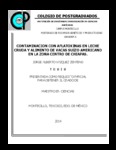| dc.contributor.author | Vázquez Zenteno, Jorge Alberto | |
| dc.creator | VAZQUEZ ZENTENO, JORGE ALBERTO; 416847 | |
| dc.date.accessioned | 2014-07-31T00:47:40Z | |
| dc.date.available | 2014-07-31T00:47:40Z | |
| dc.date.issued | 2014 | |
| dc.identifier.uri | http://hdl.handle.net/10521/2350 | |
| dc.description | Tesis (Maestría en Ciencias, especialista en Ganadería).- Colegio de Postgraduados, 2014. | en_US |
| dc.description.abstract | El tipo de alimento del ganado bovino lechero y las deficiencias en su conservación y almacenamiento, aunado a altas temperaturas y humedad relativa de las regiones tropicales incrementan el riesgo de contaminación con aflatoxinas (AF) y su posible excreción en la leche, propiciando el deterioro en la salud de los consumidores, ya que estas han sido asociadas con riesgos para la salud en humanos. La concentración máxima permitida de AFB1 en alimentos para consumo animal es de 20 μg kg-1 y de 0.5 μg L-1 de AFM1 en leche. Con el objeto de determinar los niveles de aflatoxinas totales (AFT) en el alimento y aflatoxinas M1 (AFM1) en la leche cruda, se realizó un estudio en 20 ranchos lecheros ubicados en cuatro municipios (Villaflores,Villacorzo, Ocozocoautla y Berriozabal) de Chiapas. Los análisis de AFT y AFM1 realizados en muestras de alimento y leche se realizaron empleando técnicas de ELISA. Los resultados no mostraron diferencias en los niveles de AFT entre municipios (p>0.05). Sin embargo se observó que Villaflores (27.65 μg kg-1) superó el valor permitido en la norma sanitaria de alimento. En relación a AFM1 existieron diferencias (P<0.05) entre municipios, siendo Villaflores y Villacorzo de (0.348, 0.096 μg L-1) los que alcanzaron mayores niveles, pero no superaron la norma. Además, se observó que las dietas con grano de maíz y pollinaza fueron las que se asociaron con una mayor contaminación con AFT. Se concluye que los niveles de AFM1, en el 10% de las UP, superan el valor establecido por la norma sanitaria de leche, lo cual constituye un riesgo para la salud pública. _______________ AFLATOXINS CONTAMINATION IN FOOD AND RAW MILK COWS IN SWISS AMERICAN CENTRAL OF CHIAPAS. ABSTRACT: The type of feed dairy cattle and poor preservation and storage, coupled with high temperatures and humidity of the tropics increase the risk of contamination with aflatoxin (AF ) and its possible secretion into milk , leading to deterioration in the health of consumers , as these have been associated with health risks to humans. The maximum allowable concentration of AFB1 in feed for animal consumption is 20 mg kg-1 and 0.5 mg L-1 of AFM1 in milk . In order to determine the levels of total aflatoxins (AFT) in feed and aflatoxin M1 (AFM1) in raw milk , a study was conducted on 20 dairy farms located on four municipalities (Villaflores, Villacorzo, Ocozocoautla and Berriozabal ) of Chiapas State, México . Sampling analyses of AFT in animal food and AFM1 in raw milk were performed using ELISA techniques . The results showed no difference in levels between municipalities AFT (p>0.05). However, it´s be noted that Villaflores exceeded the mexican permissible value in the standard health for food (27.65 mg kg-1). Regarding AFM1 were no differences (P<0.05) between municipalities, being Villaflores and Villacorzo (0.348, 0.096 mg L-1) which reached higher levels, but did not exceed the mexican standard. In addition, it was observed that diets with corn grain and manure were those associated with higher pollution. It’s concluded, that AFM1 levels exceeds the health standard value for milk, which is a risk to public health. | en_US |
| dc.description.sponsorship | Consejo Nacional de Ciencia y Tecnología (CONACYT). Línea 7. Inocuidad, calidad de alimentos y bioseguridad. | en_US |
| dc.language.iso | spa | en_US |
| dc.rights.uri | http://creativecommons.org/licenses/by-nc-nd/4.0 | |
| dc.subject | Bovinos trópico | en_US |
| dc.subject | Aflatoxinas AFT y AFM1 | en_US |
| dc.subject | Tropical cattle | en_US |
| dc.subject | Aflatoxin AFM1 and AFT | en_US |
| dc.subject | Ganadería | en_US |
| dc.subject | Maestría | en_US |
| dc.title | Contaminación con aflatoxinas en leche cruda y alimento de vacas suizo americano en la zona centro de Chiapas | en_US |
| dc.type | Tesis | en_US |
| Tesis.contributor.advisor | Herrera Haro, José Guadalupe | |
| Tesis.contributor.advisor | Ruíz Sesma, Benigno | |
| Tesis.contributor.advisor | Ortega Cerrilla, Ma. Esther | |
| Tesis.contributor.advisor | Barreras Serrano, Alberto | |
| Tesis.contributor.advisor | Rojas Martínez, Reyna Isabel | |
| Tesis.date.submitted | 2014 | |
| Tesis.date.accesioned | 2014-07-16 | |
| Tesis.date.available | 2014-07-30 | |
| Tesis.format.mimetype | pdf | en_US |
| Tesis.format.extent | 1,225 KB | en_US |
| Tesis.subject.nal | Leche cruda | en_US |
| Tesis.subject.nal | Raw milk | en_US |
| Tesis.subject.nal | Ganado bovino | en_US |
| Tesis.subject.nal | Cattle | en_US |
| Tesis.subject.nal | Salud humana | en_US |
| Tesis.subject.nal | Human health | en_US |
| Tesis.subject.nal | Micotoxinas | en_US |
| Tesis.subject.nal | Mycotoxins | en_US |
| Tesis.subject.nal | Calidad de la leche | en_US |
| Tesis.subject.nal | Milk quality | en_US |
| Tesis.subject.nal | Inocuidad alimentaria | en_US |
| Tesis.subject.nal | Food safety | en_US |
| Tesis.subject.nal | Vacas lecheras | en_US |
| Tesis.subject.nal | Dairy cows | en_US |
| Tesis.subject.nal | Villaflores, Chiapas, México | en_US |
| Tesis.subject.nal | Villacorzo, Chiapas, México | en_US |
| Tesis.subject.nal | Ocozocoautla, Chiapas, México | en_US |
| Tesis.subject.nal | Berriozabal, Chiapas, México | en_US |
| Tesis.rights | Acceso abierto | en_US |
| Articulos.subject.classification | Contaminación de la leche | en_US |
| dc.type.conacyt | masterThesis | |
| dc.identificator | 6 | |
| dc.contributor.director | HERRERA HARO, JOSE GUADALUPE; 9323 | |


